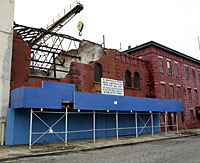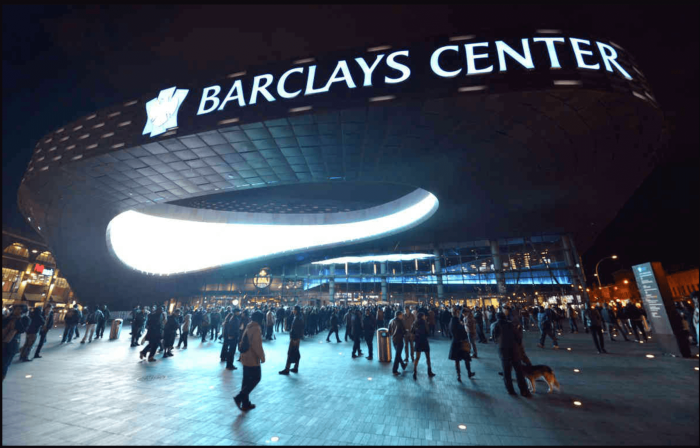Red Hook preservationists were shocked this week when cranes on the site
of a soon-to-be Ikea furniture store gouged into a complex of Civil War-era
buildings on Beard Street, despite ongoing state and federal review of
its historic significance.
Holding an impromptu press conference on Dec. 30 to address the demolition,
officials with the Municipal Art Society along with area residents were
joined by similarly upset representatives from the office of Rep. Nydia
Velazquez in front of the five buildings between Dwight and Otsego streets.
They blamed Swedish home-furnishings giant Ikea for the ruination.
The demolition equipment, which was poised mid crunch before news crews
showed up, rolled away as a crowd gathered, but were back again on Tuesday
to complete what had begun.
Meanwhile, the Municipal Art Society, a non-profit organization aimed
at preserving cultural and neighborhood character, is speedily gathering
their resources trying to figure out how to save what is left of the structures.
“Any federal agency that is going to do work has to engage in a well-defined
procedure in determining whether historical buildings will be affected,”
said Brian Connelly, who has taken charge of resisting the demolition
at the Erie Basin site. He referred to Section 106 of the National Historic
Preservation Act.
“This is not some arcane piece of legislation,” Connelly said.
“We’re very disappointed that Ikea has tried to evade this process.”
The preservation group is considering legal action against Ikea.
Ikea spokesmen said the property did not yet belong to the company, which
gained city approval last year to build a $70 million, 346,000-square-foot
store on the 22-acre former New York Shipyard, between Dwight and Columbia
streets along the Erie Basin. The company would also build 1,400 parking
spaces, a public esplanade and additional retail space.
Ikea plans to open in 2007.
Hearing Ikea’s claim of not technically owning the property yet,
Kent Barwicke, director of the Municipal Art Society, was quick to point
out, “You can’t pretend on one hand to be the owner for environmental
review, and for federal applications, and not, on the other hand, for
demolition.”
The current owners, U.S. Dredging Corporation, which is in contract to
sell the property to Ikea, applied for the demolition permits in early
December.
Asked to comment on the demolition of the potentially historic buildings,
U.S. Dredging executive Michael Gallagher said, “I have nothing to
say.”
According to the city departments of Buildings and City Planning, neither
agency has jurisdiction in preventing the demolition.
“There is nothing the Department of Buildings can do,” said
Kenneth Lazar, a Brooklyn liaison for the Buildings Department. He said
the agency “had no reason to reject the [demolition] permit,”
which was issued Dec. 7.
Ilyse Fink, a Buildings Department spokeswoman, added, “State and
national review is not meaningful,” and explained that for the city
to take action the property has to be a city landmark or under consideration
by the city Landmarks Preservation Commission.
“Even a [state or federal] landmark can be demolished,” said
Fink, adding that it happens quite often.
The Department of City Planning, which signed on as lead governmental
agency on Ikea’s city land use application, said through a spokeswoman
that although a draft Memorandum of Agreement between the state’s
Historic Preservation Officer and the U.S. Army Corps of Engineers —
which oversees all port development and waterway activity and must issue
permits for Ikea to build on the site — was in the works, it had
not yet been finalized.
“Structures were determined in our environmental review to be eligible
for the National Historical Registry, and the state’s,” said
City Planning spokeswoman Jen Parsons. She said it was her agency’s
understanding that historic mitigation was being looked into.
That mitigation, said Cathy Jimenez, a spokeswoman for the state Historic
Preservation Officer, never materialized.
“It was determined that, yes, the property was historically significant.
We’ve been working with Ikea over the past two or three years to
basically preserve the historical characteristics of the buildings,”
Jimenez said.
Her department signed on to a Memorandum of Understanding, which then
went to the Army Corps of Engineers, but, she added, “it’s up
to [the Army Corps] to authorize the permit.”
But Richard Tomer, chief of the Regulatory Branch of the New York District
of the Army Corps of Engineers, told The Brooklyn Papers that Ikea never
received permission to start work.
“Their application is incomplete, meaning they did not get a ‘go
ahead’ to work on the project,” Tomer said. He said he was concerned
that if the buildings were demolished, “we wouldn’t be able
to complete the process.”
Ikea told the Army Corps that the Beard Street building was “an immediate
hazard,” said Army Corps spokesman Peter Shugert. In response, the
Army Corps requested, in a letter both faxed and sent to Ikea, a cease
of work until they could determine whose jurisdiction the issue fell under,
as well as evidence of what made the building hazardous.
Shugert added, “It’s about due process; they need to follow
due process, and that’s what we’re trying to protect here.”
“That letter [from the Corps] was a product of our efforts to basically
enforce Section 106 of the National Historic Preservation Act,” said
Dan Wiley, a spokesman for Congresswoman Velazquez.
“Now the question is enforcement,” he said. “The [Buildings
Department] gave the owners the permit, but the permit is for alterations,
not an emergency demolition.”
Asked about forging ahead despite the historic concerns, Ikea officials
repeated their claim that the building was hazardous, and provided to
The Papers a copy of an engineer’s statement, dated Dec. 15, 2004,
by a structural engineer named Victor A. Gordon. Though the letter bore
a State of New York stamp proving his license, and was typed on letterhead,
the phone number for Gordon was disconnected, and a fax number went to
a private answering machine. A message left on the answering machine seeking
comment was not returned.
Ikea spokesman Jamie Van Bramer told The Papers the engineer conducted
the review for Ikea, as an evaluation. He would not respond to charges
that Ikea was evading the state and national historical review processes.
Connelly pointed out that the Municipal Art Society had no strong feelings
about Ikea itself.
“We are not dogmatically opposed to the Ikea project; the two can
coexist,” he said.
But Red Hookers who have opposed Ikea from the get-go used this week’s
demolition as an opportunity to reiterate their position.
“An awful lot of people in Red Hook have been deceived by this project,”
said John McGettrick, president of the Red Hook Civic Association. “This
basically constitutes an end-run around the regulatory process. An illegal
end-run.”
Red Hook Councilwoman Sara Gonzalez, on the other hand, who championed
the Ikea project, appears to support the demolition.
“She is not going to renege on a commitment she made to the whole
of a community,” said her spokesman, Felix Palacios.
“She’s completely convinced that what she did, that whatever
needs to be done to bring about this project, needs to be done,”
he added. “She’s in complete agreement with bringing Ikea to
Brooklyn.”
That did not sit well with McGettrick.
“I am hoping, as more information becomes available, that [Gonzalez]
will reconsider,” he said.























